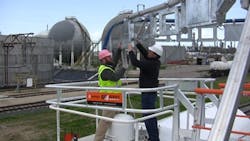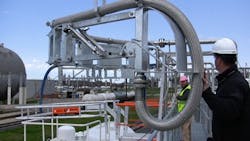Material Handling: Plant Enhances Loading/Unloading Operations
Handling liquid bulk materials can pose substantial hazards. Indeed, in 2008 when the U.S. Department of Transportation’s Pipeline and Hazardous Materials Safety Administration (PHMSA) proposed recommended best practices for loading and unloading operations [1], it noted “roughly one-quarter to one-half of all serious hazardous materials incidents may be associated with loading and unloading operations involving bulk packaging such as cargo tank motor vehicles (CTMV) and rail tank cars.” That report indicated the number of incidents had “remained relatively unchanged over the last ten years.”
There has been progress. A spot check of incident reports (via [2]) from the PHMSA Office of Hazardous Materials Safety comparing 2006 with 2016 shows improved loading-and-unloading safety and efficiency.
Table 1. Incidents with tank trucks and rail tank cars decreased markedly over a 10-year span.
As Table 1 details, the overall number of incident reports involving the loading or unloading of CTMVs and railcars that resulted in a spill, fire, explosion, material entering a waterway or storm sewer, vapor escaping or environmental damage was 95% lower in 2016 than ten years earlier. The number of injuries declined by 29% and monetary damages fell 300%.
However, at least one area lags the others. The number of incidents caused by hoses, hose adapters or couplings decreased far less over those ten years than those due to other causes (Table 2). This raised the percentage of incidents stemming from hose-related failures from 15% in 2006 to 27% in 2016.
Table 2. Hoses and related components in 2016 accounted for more than one quarter of failures.
Hose Loading Arms
One way to improve safety and efficiency during the bulk loading and unloading process is to install and use hose loading arms. That’s what Hawkins, Inc. decided after the company opened a new 65,000-ft2 manufacturing facility in Rosemount, Minn. It installed a Roman Seliger SGA loading arm in the second quarter of 2016 to facilitate unloading bulk chemicals at a rail spur on the plant grounds.
“We came across their display at the Chem Show and were intrigued by the concept,” says Greg Ohlhues, Hawkins’ operations engineering manager. “We had a new handling application which was going to require a dedicated handling area. Previously, due to the number of products we typically handle in an area, we had to go with applications that provided for more clutter for the operators to work around. However, we liked the idea of getting the unloading hose up and out of the way for the operators while also making it easier to maneuver.”
Figure 1. System minimizes risk of damage to hose while making maneuvering of it easier.
The SGA loading arm allows hoses to rest on a series of galvanized or stainless-steel frame segments (Figure 1); the loading arm carries the entire weight of product and the hose assembly. Rather than physically drag and lift heavy hoses with large couplings, operators easily maneuver the loading arm into position. Hawkins opted for an optional vertical height adjustment mechanism that allows for up or down movement to the loading/unloading point.
The system features a flexible joint mechanism that’s easier to operate than more-expensive fixed swivel systems. The loading arm is designed to prevent wear and tear to the hose assembly and doesn’t allow the operator to over-bend or kink the hose. The loading arm itself comes with lifetime bearings; there are no swivel seals that wear out and need replacement. An arm can handle hose assemblies from 1-in. to 4-in. inner diameter and lengths up to 20 ft. While Hawkins only requires one hose assembly on an arm, systems can be designed to handle multiple assemblies.
“The installation was pretty straightforward after we determined the structural needs to support the arm and hose combination,” Ohlhues notes. “The implementation went well and we are considering this style arm for other applications, too.”
From an elevated platform, operators at the Rosemount facility swing the arm and unloading hose assembly over the top of a railcar (Figure 2). They then use the height adjustment mechanism to lower the end coupling into position and then connect it to the coupling at the top of the railcar. When unloading is completed, an operator uncouples the hose assembly and swings the arm and hose assembly back to the storage position.
Figure 2. Arm supports the entire weight of hose, reducing the physical burden on operators.
“We’ve found the benefits to be exactly what we were looking for. It decluttered the work space and improved handling by the operators. They no longer have to lift and drag the unloading hose across the gangway to the railcar. Plus, the arm lowering and lifting mechanism by the railcar connection makes it easy for them to work around the fall protection cage,” Ohlhues explains. “One additional advantage we did not foresee was with the way the connection is made to the car. It removes stress on the hose crimped connection and railcar connection nozzle by being able to come straight off the top of the railcar with the hose being supported independently.”
Loading systems can optimize both safety and handling. They prevent torsion, bending and tensile loads. They increase the lifespan of hoses by eliminating damage from friction with the ground or from vehicles driving over them. More importantly, they reduce the physical burden on employees to a minimum, while making connecting hoses effortless and precise.
The systems are relatively modest in cost: Typical galvanized steel loading arms (without the optional height adjustment feature) that can handle 3-in. × 15-ft hose assemblies start at under $10,000, while stainless-steel versions cost a couple of thousand dollars more.
Widespread adoption of loading arms throughout the chemical industry almost certainly would reduce the number of PHMSA incident reports involving hoses in the loading/unloading process.
WILLIAM LESSER is global RS manager for Husky Corp., Pacific, Mo. Email him at [email protected].
REFERENCES
1. “Proposed Recommended Practices for Bulk Loading and Unloading of Hazardous Materials in Transportation,” Pipeline and Hazardous Materials Safety Administration, Washington, D.C., (2008)
2. “Incident Reports Database Search,” Pipeline and Hazardous Materials Safety Administration, Washington, D.C., (2017)
3. “Cargo Tank Motor Vehicle Loading/Unloading Operations: Recommended Best Practices Guide,” Pipeline and Hazardous Materials Safety Administration, Washington, D.C.




